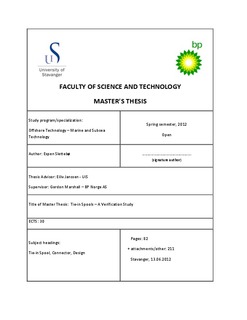| dc.description.abstract | Within the Oil industry, subsea pipelines are used to transport hydrocarbons from one location to
another. After the installation of a subsea pipeline, the final connection between the pipeline ant the
interconnecting facilities are done by using tie-in spools. In principle, tie-in spools serve two
purposes. First, it needs to provide an interface that bridges the inaccuracies associated with
offshore pipeline installation. Inaccuracies related to pipeline installation are numerous, but can be
related to the existing seabed infrastructure, orientation/position of the tie-in facilities with respect
to pipeline installation vessel, bathymetry & soil accuracy of data among others. These factors cause
the tie-in spool to be measured, fabricated and installed after the pipeline has been laid in order to
make up the connection. Secondly, the tie-in spool needs to be a flexible element as pipelines
expands during operational conditions because of heat and pressure differences between
installation and operational stages. By the tie-in spool being flexible, the forces in connectors are
reduced in order to ensure safe transportation of hydrocarbons. These key requirements can have
significant impact of the overall cost of a project as they will affect all necessary operations related
to tie-in spools.
This report assesses key requirements related to tie-in spools by a detailed review about issues
related to the design, fabrication, installation and operation of tie-in spools. By presenting details
from the design of an actual installed tie-in spool in the southern North Sea this is sought achieved.
By presenting a tie-in spool and its important design parameters, load steps that it is subjected to,
and the results from loading analysis it is wanted to educate about the importance of tie-in spools.
A modification of the tie-in spool where done to develop a simple technique to quickly assess the
preliminary design/configuration of a tie-in spool based on bending moment capacity of the
associated connector. The design parameters, such as pipeline expansion, where extracted from the
presented tie-in analysis. Four different analysis methods where used in order to give
recommendations on which method are most suited for spool piece analysis. By comparing results
with the actual installed spool, calculated results showed that three methods can be suited for
simplified spool piece analysis.
In order to qualify one of the analysis methods, a downscaled tie-in spool was manufactured based
on the modified spool. By innovative use of simple mechanical equipment, the tie-in spool was
applied pipeline expansion via a winch. The bending moment in the connector where measured
using an adjustable torque wrench. Measured bending moment was compared to the analysis
methods and by comparison it was evident that numbers did not correlate. Due to this, no further
recommendation on suitable analysis method could be given. A search for possible error sources
contributing to no correlation was conducted. It is also proposed further development of
experiment. | no_NO |
